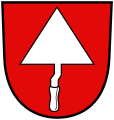Trowel
The trowel , regional (Rheinland) also truffle called, is a tool of the mason for the processing of the mortar in walls or brushing . The trowel blade can have a triangular or square basic shape.
nature
The handle is connected to the blade of the trowel by a curved connection (S-shape, also called gooseneck). Trowels with a straight neck and a trapezoidal blade are cleaning trowels. Trowels with an elliptical blade (heart trowel) are used by tilers. The side length of the trowel should be approximately identical to the brick length (normal format brick: length = 24 cm, width = 11.5 cm, height = 7.1 cm) so that the mortar taken up for a brick can completely fill the mortar bed.
application
When choosing a triangular trowel, it is important to pay attention to a favorable center of gravity . This is determined by placing the trowel exactly below the handle (for example on the index finger ). The trowel blade should level off horizontally. This is important because when picking up the mortar and especially when cleaning, the weight must be balanced with the wrist . It is also important that the axis of the trowel handle points exactly to the tip of the trowel. Since this is often not the case, the bricklayer often trowels himself with a hammer.
The triangular trowel is also used for cleaning larger areas. After picking up the plaster mortar, the trowel is moved away from the surface in order to gain momentum. Then the trowel is turned from the wrist so that the blade is vertical. The mass is pressed onto the blade by the rotary movement. The top of the sheet with the mortar now points towards the wall surface. The trowel is now guided to the point where the mortar should adhere. By pulling the trowel sideways (backhand: away from the body, forehand: towards the body), the mortar is loosened from the blade. Here, the side of the leaf from which the mortar is detached is guided along the wall in parallel so that the mass is distributed in the desired direction.
The square shape is also suitable for chimney construction with narrow chimneys, whereby the protruding mortar in the chimney can be removed and the joints closed. The square shape is not very suitable for plastering work.
variants
Before the invention of the cleaning machine , special cleaning trowels with very large blades were used in order to be able to throw on as large an area as possible quickly.
There are numerous special trowels such as:
- Berlin trowel
- Trowel
- Cleaning trowel (regional: Schwebchen)
- Joint trowel
- Smoothing trowel (or trowel)
- Tongue trowel , cat's tongue, a trowel with a rounded tip
- u. v. m.
Smaller triangular trowels are also used in archaeological excavations for the careful and slow removal of layers of earth and culture. Because of the large leverage that sometimes occurs, trowels are preferred whose metal parts consist of one piece.
heraldry
The trowel , even trowel or short only as a trowel is designated in the heraldry a common figure , and only in recent Heraldry in the coat of arms to be found.
Represented trowel according to the model of the tool of the same. Usually the trowel appears two-dimensional and the blade points towards the upper edge of the shield as a basic position. A triangular or square trowel and deviating positions should always be reported. The trowel is then z. B. "overthrown" or with the tip to the sign foot to showing emblazon . Different names for the trowel are to be specifically mentioned if they are in the coat of arms, but have no special effects in the representation in the coat of arms or field. In the trowel group, there can be a trowel, the Berlin trowel or the pointed and cleaning trowel or joint trowel, but also the smoothing trowel. The coloring is possible with all heraldic tinctures, but is often only different to the touch.
Johann Ohnefurcht used the trowel as a badge and as an expression of his motto “I houd - I stand up”.
The trowel is also the symbol in the craftsman's or trade coat of arms .
Mason's trowel in the coat of arms of Ratshausen
literature
- Anton Kohl, Kurt Bastian, Ernst Neizel: Building expertise. Basics, BG Teubner Verlag, Stuttgart 1995, ISBN 978-3-322-91838-3 .
See also
Web links
Individual evidence
- ^ Fanny Bury Palliser: Historic Devices, Badges, and War-Cries. sn, London 1870, p. 35.









